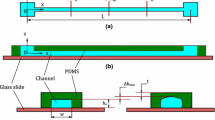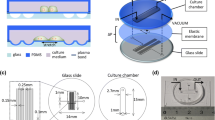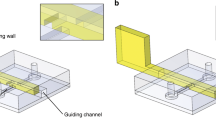Abstract
In the emerging field of deformable microfluidics, we propose a new geometry in which the height and angle of a channel are controlled, thanks to the deformability of the microfluidic elastomer down to thicknesses of a few microns. The particularity of our set-up is that the height of the channel under study is fully closed at rest, which reveals especially well suited to address micro-nanoconfinement problems such as clogging, transport selectivity and flow rectification. Using fluorescence microscopy and light absorption, we probe the channel shape from the measurement of the PDMS-displacement field. We demonstrate that the maximal PDMS displacement can be inferred from finite elements numerical simulations and predicted reliably with simple analytical relations from elasticity continuum mechanics.







Similar content being viewed by others
References
Armani DK, Liu C, Aluru NR (1999) Re-configurable fluid circuits by pdms elastomer micromachining. Technical Digest. IEEE International MEMS 99 Conference. Twelfth IEEE International Conference on Micro Electro Mechanical Systems (Cat. No.99CH36291), pp 222–227
Bobak M, Tom B, Joong P, Mark AB, Shuichi T (2011) Next-generation integrated microfluidic circuits. Lab Chip 11:2813–2818
Brunet P, Eggers J, Deegan RD (2007) Vibration-induced climbing of drops. Phys Rev Lett 99(14):144501
Cejas Cesare M, Monti F, Truchet M, Burnouf J-P, Tabeling P (2018) Universal diagram for the kinetics of particle deposition in microchannels. Phys Rev E 98:062606. 10.1103/PhysRevE.98.062606. https://link.aps.org/doi/10.1103/PhysRevE.98.062606
Chaudhury MK, Whitesides GM (1992) How to make water run uphill. Science 256(5063):1539–1541
Grover W, Skelley A, Liu C, Lagally E, Mathies R (2003) Monolithic membrane valves and diaphragm pumps for practical large-scale integration into glass microfluidic devices. Sens Actuat B 89:315–323
Joong P, Sung Y, Eun-Joong L, Lee DH, Kim JY, Lee S-H (2010) Increased poly(dimethylsiloxane) stiffness improves viability and morphology of mouse fibroblast cells. BioChip J 4:9. https://doi.org/10.1007/s13206-010-4311-9
Leslie DC, Easley CJ, Seker E, Karlinsey JM, Utz M, Begley MR, Landers JP (2009) Frequency-specific flow control in microfluidic circuits with passive elastomeric features. Nat Phys 5(3):231–235
Lorenceau E, Quere D (2004) Drops on a conical wire. J Fluid Mech 510:29–45
Mehboudi A, Yeom J (2019) Experimental and theoretical investigation of a low-reynolds-number flow through deformable shallow microchannels with ultra-low height-to-width aspect ratios. Microfluid Nanofluid 23(5):66
Petit P, Seiwert J, Cantat I, Biance A-L (2015) On the generation of a foam film during a topological rearrangement. J Fluid Mech 763:286–301
Pittman JL, Henry CS, Gilman SD (2003) Experimental studies of electroosmotic flow dynamics in microfabricated devices during current monitoring experiments. Anal Chem 75(3):361–370
Prasath Natarajan G, Kim S-J, Kim C-W (2017) Analysis of membrane behavior of a normally closed microvalve using a fluid-structure interaction model. Micromachines 8(355):1–15
Raj A, Sen AK (2016) Flow-induced deformation of compliant microchannels and its effect on pressure-flow characteristics. Microfluid Nanofluid. https://doi.org/10.1007/s10404-016-1702-9
Raj A, Suthanthiraraj PPA, Sen AK (2018) Pressure-driven flow through pdms-based flexible microchannels and their applications in microfluidics. Microfluid Nanofluid 22(11):128. https://doi.org/10.1007/s10404-018-2150-5
Reyssat E (2014) Drops and bubbles in wedges. J Fluid Mech 748:641–662
Reyssat M, Pardo F, Quere D (2009) Drops onto gradients of texture. EPL 87(3):36003
Shastry A, Case MJ, Bohringer KF (2006) Directing droplets using microstructured surfaces. Langmuir 22(14):6161–6167
Song-Bin H, Yang Z, Deyong C, Hsin-Chieh L, Yana L, Tzu-Keng C, Junbo W, Jian C, Min-Hsien W (2014) A clogging-free microfluidic platform with an incorporated pneumatically driven membrane-based active valve enabling specific membrane capacitance and cytoplasm conductivity characterization of single cells. Sens Actuat 190(Complete):928–936. https://doi.org/10.1016/j.snb.2013.09.070
Tang SKY, Whitesides GM (2010) Basic microfluidic and soft lithographic techniques. In: Optofluidics - fundamentals, devices and applications. McGraw-Hill, New York
Tang SKY, Whitesides GM (2010) Basic microfluidic and soft lithographic techniques, 7th edn. McGraw-Hill, New-York
Thorsen T, J Maerkl S, Quake SR (2002) Microfluidic large-scale integration. Science 298(5593):580–584
Unger M, Chou H-P, Thorsen T, Scherer A, Quake SR (2000) Monolithic microfabricated valves and pumps by multilayer soft lithography. Science 288(5463):113–116
Weaver J, Melin J, Stark D, Quake S, Horowitz M (2010) Static control logic for microfluidic devices using pressure-gain valves. Nat Phys 6(3):218–223
Zheng Y, Bai H, Huang Z, Tian X, Nie F-Q, Zhao Y, Zhai J, Jiang L (2010) Directional water collection on wetted spider silk. Nature 463(7281):640–643
Acknowledgements
We sincerely thank Jean-Claude Vial, Aurelien Gourrier and Irene Wang for their time and help obtaining successful quantitative optical measurements. We also appreciate Saranath Seshadri’s support on Comsol utilization and Daniele Centanni for microfluidic preparation. We acknowledge Elisabeth Charlaix and Benjamin Cross for stimulating discussions and TOTAL SA for funding.
Author information
Authors and Affiliations
Corresponding author
Ethics declarations
Conflict of interest
The authors declare that they have no conflict of interest.
Additional information
Publisher's Note
Springer Nature remains neutral with regard to jurisdictional claims in published maps and institutional affiliations.
Rights and permissions
About this article
Cite this article
Velasco Anez, D., Hadji, C., Santanach-Carreras, E. et al. Microfluidic channels of adjustable height using deformable elastomer. Microfluid Nanofluid 25, 7 (2021). https://doi.org/10.1007/s10404-020-02408-5
Received:
Accepted:
Published:
DOI: https://doi.org/10.1007/s10404-020-02408-5




